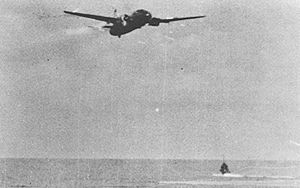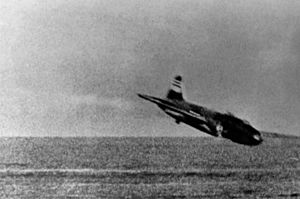Action off Bougainville facts for kids
The Action off Bougainville was a naval and air battle during World War II in the South Pacific Theater. It happened on February 20, 1942, near Bougainville Island in Papua New Guinea. A United States Navy group, led by Admiral Wilson Brown, was heading to attack a Japanese base at Rabaul. But they were attacked by land-based bombers from the Imperial Japanese Navy.
During the fight, the Japanese lost 15 out of 17 bombers that attacked the American ships. The United States lost only two fighter planes, and no ships were damaged. Because the Japanese knew the Americans were coming, the US forces decided not to attack Rabaul and turned back. The Japanese had lost so many bombers that they had to delay their plan to invade New Guinea. This gave the Allies more time to get ready for future Japanese attacks in the South Pacific.
Quick facts for kids Action off Bougainville |
|||||||
|---|---|---|---|---|---|---|---|
| Part of the Pacific Theater of World War II | |||||||
 A Japanese 4th Air Group Type 1 bomber, commanded by the strike leader, Lieutenant Commander Takuzo Ito, approaches Lexington during the action. The bomber, already missing one engine after an attack by a Wildcat fighter piloted by "Butch" O'Hare moments earlier, crashed into the ocean shortly after this picture was taken. |
|||||||
|
|||||||
| Belligerents | |||||||
| Commanders and leaders | |||||||
| Strength | |||||||
| 1 aircraft carrier 4 cruisers 10 destroyers 19 fighters |
17 bombers 5 scouts |
||||||
| Casualties and losses | |||||||
| 2 fighters destroyed 1 killed |
19 aircraft destroyed 130 killed |
||||||
Contents
Why the Battle Happened
After capturing the port of Rabaul in 1942, Japanese forces turned it into a major military base. The Allied commanders were worried that Rabaul's capture threatened the important sea route between San Francisco and Australia. This route was used to send supplies.
To deal with this threat, Admiral Chester William Nimitz and Admiral Brown planned to attack Rabaul. The US Task Force 11 (TF 11) and the ANZAC Squadron were given this mission. However, the ANZAC Squadron did not have enough fuel to join TF 11 for the planned air strike.
The Battle Begins
TF 11, which included the carrier Lexington, detected an unknown aircraft on radar. This was about 35 miles from the ship. Two US fighter planes were sent to investigate. They shot down a Japanese four-engined "Mavis" flying boat. Later, they shot down a second "Mavis" plane.
These Japanese search planes warned Rabaul that US naval forces were in the area. Vice Admiral Shigeyoshi Inoue ordered an air strike from Rabaul. He also ordered several heavy cruisers to intercept TF 11.
Japanese Bombers Attack
Seventeen Japanese "Betty" bombers took off from Rabaul to attack TF 11. When Admiral Brown realized the Japanese knew his location, he decided to cancel the attack on Rabaul. He began to move his ships away from the area.
US radar soon detected the Japanese bombers approaching. Six Wildcat fighters from Lexington were sent to stop them. Five of the nine incoming "Betty" bombers were shot down or forced out of their formation. One of these was the lead plane, which caused a delay in the Japanese attack. The remaining four "Betty" bombers tried to attack, but US fighters and Captain Frederick C. Sherman's skillful ship handling caused their bombs to miss the carrier.
One damaged Japanese bomber then tried to crash directly onto Lexington's flight deck. Captain Sherman quickly turned the ship, and all available guns fired at the bomber. The plane crashed into the water behind the carrier. The remaining four "Betty" bombers tried to escape but were attacked by Wildcats. Three were shot down, and the last one was shot down by a US SBD dive bomber.
Butch O'Hare's Heroism
A second group of "Betty" bombers was detected by radar. Only two Wildcats were available to fight them: one flown by Lieutenant Edward "Butch" O'Hare and the other by Lieutenant (junior grade) Marion Dufilho. Dufilho's guns jammed, leaving O'Hare to face the bombers alone.
O'Hare attacked the eight Japanese bombers with great skill. He made several passes, firing his guns and hitting multiple planes. He managed to damage or shoot down several bombers, preventing them from completing their attack. His quick and brave actions saved the Lexington from serious damage.
The remaining Japanese pilots dropped their bombs. Three of them aimed at Lexington, but their bombs landed close but did not hit the ship. Another plane aimed at the cruiser Minneapolis but also missed.
As the surviving "Betty" bombers left, one damaged Japanese plane tried to crash into Lexington, but it also missed and crashed into the water. Of the remaining Japanese planes, one was shot down, and another was badly damaged and had to crash-land. Only two of the second group of bombers made it back to their base.
Aftermath
Because the element of surprise was lost, Admiral Brown cancelled the planned raid on Rabaul. The US forces then left the area. The Japanese had lost so many bomber aircraft that they had to delay their planned invasion of Lae-Salamaua from March 3 to 8, 1942.
In total, the US shot down 19 Japanese aircraft, including the bombers and several scout planes. The US lost two fighters, but one pilot survived, and no US warships were damaged. For his incredible bravery and skill in shooting down multiple enemy planes, Edward O'Hare was awarded the Medal of Honor, the highest military award in the United States.
Images for kids




